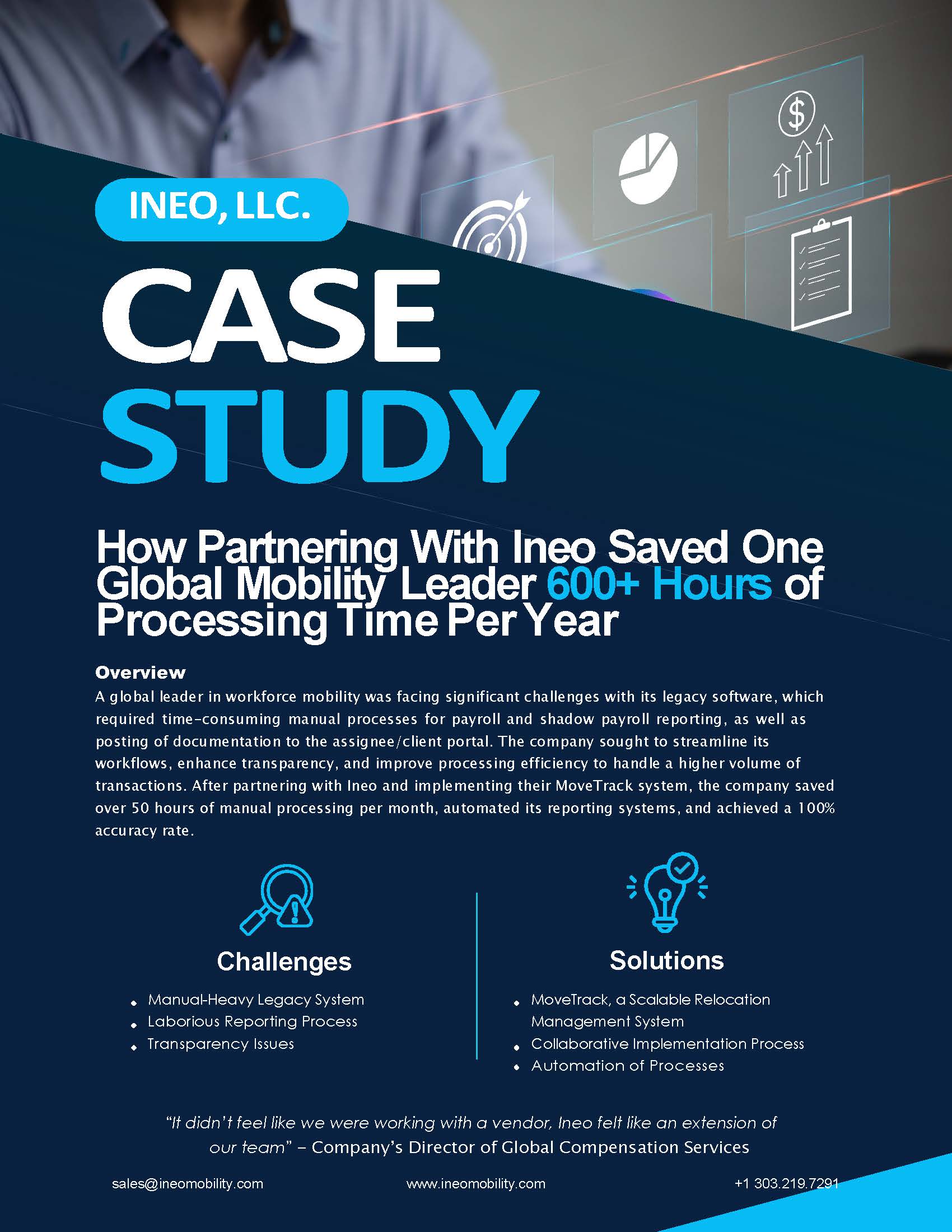The Tax Deductibility of Disaster Relief and Medical Travel Benefits

Employee benefits packaging can make or break your global mobility program
It’s no secret that benefits included in your company’s employment package can significantly contribute to employee satisfaction. For example, your benefits package may include important access to healthcare, an enticing retirement plan, and paid time off – all attractive factors to potential employees. As a result, employees who receive benefits experience higher job satisfaction, which decreases turnover rates and increases retention. In addition, offering employee benefits is a recruiting advantage, which is essential in the current labor market.
While benefits may give your company an edge in talent retention, they also represent a company’s ethical responsibility to its employees – as in the case of employer-sponsored disaster relief benefits. For example, many companies saw their employees suffer financial difficulties due to the COVID-19 pandemic. Understandably, they sought to offer assistance to their staff through disaster relief payments. Similarly, many companies are reworking their employee benefits in response to medical care availability and affordability developments to include reimbursements for employee medical-related travel expenses.
While disaster relief payments and medical-related travel reimbursements are positively impactful, these payments may come with tax implications for employers and employees alike.
Qualified disasters and disaster-related relief payments
According to I.R.C. Section 139 of the Internal Revenue Code, the term “qualified disaster” includes a disaster determined by the President to warrant assistance by the Federal government under the Robert T. Stafford Disaster Relief and Emergency Assistance Act, 42 U.S.C. 5121 – 5207. When the President makes such a declaration, Section 139 goes into effect. Passed in 2001 after the 9/11 terrorist attacks, this tax enactment was intended to encourage employers to provide financial assistance to their employees during times of crisis.
A “qualified disaster relief payment” is defined by section 139 as any payment made to or for the benefit of an individual to reimburse or pay reasonable and necessary personal, family, living, or funeral expenses incurred as a result of a qualified disaster and pandemic emergency.
Employers are not obligated to make these optional reimbursements. However, many choose to provide benefits to their employees in the name of goodwill and corporate responsibility.
Natural disaster-related relief payments
Qualified disasters take multiple forms, including natural disasters. A natural disaster is a significant geological or meteorological event potentially resulting in a loss of possessions, property, or even life. In addition, natural disasters threaten crucial infrastructure and may cause periods of insecurity, turmoil, and economic loss.
Examples of natural disasters include:
- Tornadoes and Severe Storms
- Earthquakes
- Wildfires
- Floods
- Drought
- Hurricanes and Tropical Storms
If employers provide direct assistance to employees in need during a qualified natural disaster without going through a charitable organization, assistance isn’t considered taxable income for employees. Payments made to reimburse or cover reasonable and necessary expenses aren’t subject to federal income taxation and shouldn’t be included as wages when employees file their taxes.
These expenses include personal, living, family, or funeral costs incurred due to a qualified natural disaster. In addition, reasonable expenses include repairs to a personal residence damaged by a qualified natural disaster, provided these costs are not otherwise reimbursed by insurance. Qualified natural disaster relief payments may also include payments made to foster employee welfare. These welfare payments are only eligible if made by a federal, state, or local government agency and not otherwise reimbursed by insurance.
Qualified disaster relief payments exclude earnings replacement payments, such as lost wages or business income, and unemployment compensation.
COVID-related disaster relief payments
In 2020, the federal government proclaimed the coronavirus (COVID-19) pandemic a national emergency; the qualified disaster determination comprised all 50 states, the District of Columbia, and all U.S. Territories. Because of this determination, employers may reimburse their employees for many expenses from the pandemic. COVID-19-related reimbursements are tax-free to the employee and deductible by the employer.
Despite the pandemic being deemed as a qualified disaster for purposes of section 139 of the Code, qualified wages aren’t considered excludable relief payments. This is because an employee’s qualified wages are earned compensation rather than payments made to reimburse expenses incurred due to COVID-19.
Qualified COVID disaster relief payments may include:
- Uninsured and unreimbursed medical expenses (including deductibles, co-pays, prescriptions, and over-the-counter medications)
- Health-related costs that are not medical expenses, such as hand sanitizer, disinfectant supplies, and supplements
- Expenses for establishing or maintaining a home office (for example, speedier internet connections, computers, and other work-related electronics)
- Increased expenses due to being quarantined (for example, higher utility payments)
- Increased commuting costs (for example, taking rideshares to work instead of public transit)
- Accommodation for additional household members
- Increased childcare fees (including tutoring due to school closures)
- Funeral costs for pandemic-related deaths.
No substantiation needed for disaster-related relief payments
Due to the unusual circumstances surrounding a qualified disaster, employers aren’t obligated to make disaster relief payments under a plan document. In addition, employees aren’t required to account for actual expenses to qualify for the exclusion, provided that payments can be reasonably anticipated to be commensurate with incurred costs.
This condition of the tax law only comes into effect during times of emergency, so it overrules standard recordkeeping and substantiation conditions.
Medical-related travel reimbursement benefits
Many employers are designing benefits that encourage or support employees to travel for medical care due to the rising health care costs or the accessibility of services. These medical travel reimbursement benefits ensure an employee’s scope of medical care isn’t limited to their location, enabling an employee to receive care under an appropriate provider. If medical-related travel expenses are reimbursed by an employer, they are considered taxable W-2 wages and employers will need to decide if they want to gross-up those reimbursed expenses.
Similar to qualified disaster relief payments, employers aren’t legally obligated to reimburse their employees’ expenses accrued while traveling to receive medical care. However, like disaster relief payments, these benefits promote goodwill and employee retention.
The following examples of medically-related travel expenses are considered eligible for tax deduction:
Transportation expenses primarily for and necessary to acquire medical care in another location, including:
- Bus, train, or plane fares
- Car or rideshare services
- Mileage reimbursements
- Transportation costs of a parent accompanying a child in need of medical care
- Transportation expenses of a nurse or other medically-trained person who can provide the treatment needed by a patient unable to travel alone for medical care
- Lodging expenses accrued while receiving medical care away from home, provided the costs meet the following requirements:
- The lodging is primarily for, and necessary to, medical care.
- A doctor gives medical care in a licensed hospital or a medical facility related to or equivalent to a licensed hospital.] There’s no noteworthy aspect of recreation or vacation during the travel.
- The lodging isn’t considered extravagant.
The maximum amount for eligible medical-related lodging expenses is $50 per person per night. For instance, if a parent travels with a child, up to $100 per night would be eligible for reimbursement.
Car expenses associated with driving to receive medically necessary treatment. The I.R.S. authorizes a standard medical mileage rate annually; the rate for 2022 is $0.22 per mile. Because it’s straightforward, most people elect to use the medical mileage rate. Parking fees and tolls are also eligible.
The IRS also permits a more complicated methodology for actual expenses for operating your vehicle for medical treatment. This methodology includes determining out-of-pocket costs, such as gas, oil, tolls, and parking. However, depreciation, insurance, repairs, or maintenance expenses are ineligible.
A percentage cap on tax deductibility
For individuals, medical-related travel expenses are only tax-deductible to the extent they exceed 7.5% of Adjusted Gross Income (A.G.I.). Because of this threshold, most employees will be unable to deduct many medical-related travel expenses. Gross-up considerations will need to be taken into account.
Non-deductible medical travel expenses
Excluded medical travel expenses include:
- Meals (other than those provided through inpatient care)
- Extending a medical trip for vacation or personal enjoyment
- Childcare expenses/babysitting
- Costs for a caregiver or travel companion, except:
- A parent traveling with a minor under the age of 18
- An eligible caregiver (such as a nurse) who can administer medication
The industry choice for global mobility tax expertise
Ineo Tax Services provides the know-how necessary to ensure your global mobility program is completely compliant while maximizing your tax deduction opportunities. From mobility tax policy consultation to responsive global tax services, our industry experts cover all your global mobility tax needs. Contact our industry experts to learn how partnering with Ineo can help you reach your mobility program’s goals today.
Global Mobility Resources
Learn more about what’s going on at Ineo and insights into the complex world of global mobility from the industry’s top thought leaders and innovators.
Request A Demo
Whether you are new to the world of global mobility or you’ve been in the business for a while, Ineo is here to assist you.
The best way to learn how Ineo’s global mobility software can help your company revolutionize your global mobility program and support your business strategy is to see it in a demo.
Fill out this form to get started today.
Get Started






